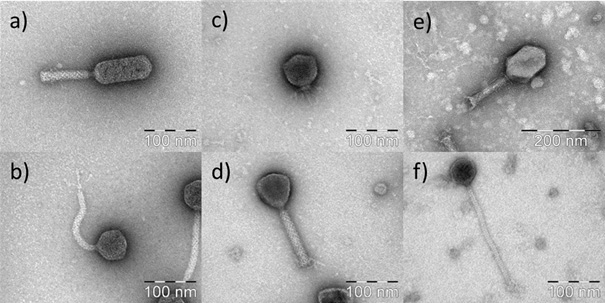Bacteriophages are increasingly being investigated as promising biocontrol tools for enhanced food safety, in particular with respect to minimizing antibiotic-resistant bacteria, as well as human pathogenic bacteria in the food supply. Therefore, various bacteriophages were isolated from environmental samples within the framework of a current departmental research project on antibiotic resistant bacteria. Overall, more than 40 different phages were isolated and characterized on basis of their morphology, RAPD patterns, host spectra and DNA restriction patterns. According to their morphological characteristics, these phages could be assigned to the Myoviridae, Siphoviridae and Podoviridae (Fig.) phage families. Phage screening was done with representative EHEC strains, antibiotic-resistant E. coli isolates and strains of Klebsiella and enterococci, respectively. For a better understanding of the biodiversity of the phage populations, DNA sequence analysis of selected phage genomes is presently in progress. Interestingly, the phages revealed diverse and distinct host ranges: A remarkably broad host range was detected for one phage infecting all of the tested EHEC strains used in our study. Contrarily, the host range of another phage was more restricted to E. coli O157:H- and O157:H7 strains. One particular phage, lytic for different antibiotic-resistant E. coli strains could also lyse a Salmonella strain.
In conclusion, environmental samples contain a broad spectrum of bacteriophages lytic for E. coli, Klebsiella and vancomycin-resistant Enterococcus faecium and E. faecalis strains. Hence, these phages may have potential as alternative biocontrol agents for antibiotic-resistant or pathogenic bacteria in foods.


